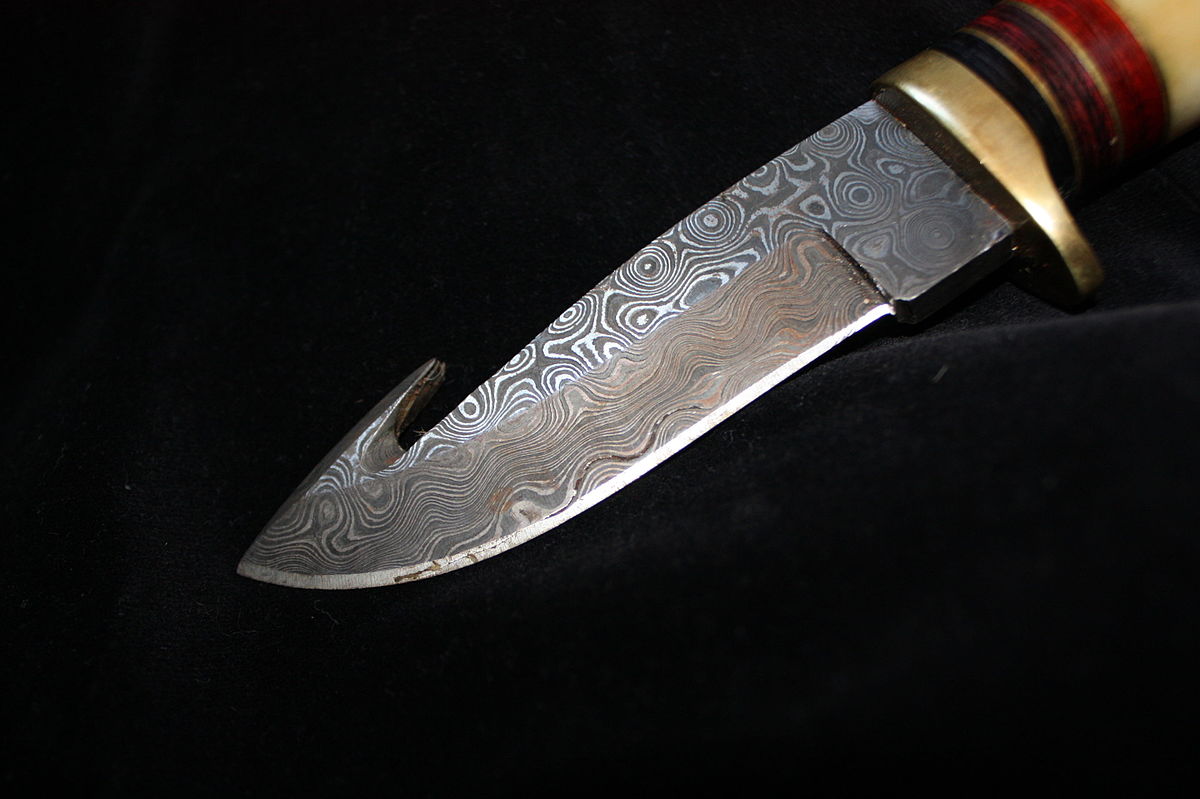Difference between revisions of "The Art of Sword Forging"
From Londonhua WIKI
(→Inscriptions) |
(→Blade Decorations) |
||
| Line 29: | Line 29: | ||
<br> | <br> | ||
[[File: Damascus steel hunting knife (4121913093).jpg|x320px|thumb| Attributed to Rich Bowen from Lexington, KY, USA (Damascus steel hunting knife) [CC BY 2.0 (http://creativecommons.org/licenses/by/2.0)], via Wikimedia Commons]]<br> | [[File: Damascus steel hunting knife (4121913093).jpg|x320px|thumb| Attributed to Rich Bowen from Lexington, KY, USA (Damascus steel hunting knife) [CC BY 2.0 (http://creativecommons.org/licenses/by/2.0)], via Wikimedia Commons]]<br> | ||
| − | Damascus steel swords were very popular during the medieval period due to there combination of strength and flexibility. | + | Damascus steel swords were very popular during the medieval period due to there combination of strength and flexibility. Using Damascus Steel causes a water ripple looking pattern in the blade. For this reason many smiths found ways to copy the pattern despite not having the steel. The patterning was entirely for aesthetic uses and had no real meaning beyond the implication that it was a high quality sword which may or may not have been true depending on whether or no it was Damascus steel and if it was forged properly.<ref>Durand-Charre, M. (2014). Damascus and pattern-welded steels forging blades since the iron age. Les Ulis (Essonne): EDP sciences.</ref><br><br> |
===Inscriptions=== | ===Inscriptions=== | ||
Revision as of 06:09, 22 June 2017
Art in Sword Forging
 Deliverable Sword by Tower Hill |
__TOC__.
Contents
Abstract
The paragraph should give a three to five sentence abstract about your entire London HUA experience including 1) a summary of the aims of your project, 2) your prior experience with humanities and arts courses and disciplines, and 3) your major takeaways from the experience. This can and should be very similar to the paragraph you use to summarize this milestone on your Profile Page. It should contain your main Objective, so be sure to clearly state a one-sentence statement that summarizes your main objective for this milestone such as "a comparison of the text of Medieval English choral music to that of the Baroque" or it may be a question such as "to what extent did religion influence Christopher Wren's sense of design?"
Introduction
I suggest you save this section for last. Describe the essence of this project. Cover what the project is and who cares in the first two sentences. Then cover what others have done like it, how your project is different. Discuss the extent to which your strategy for completing this project was new to you, or an extension of previous HUA experiences.
As you continue to think about your project milestones, reread the "Goals" narrative on defining project milestones from the HU2900 syllabus. Remember: the idea is to have equip your milestone with a really solid background and then some sort of "thing that you do". You'll need to add in some narrative to describe why you did the "thing that you did", which you'd probably want to do anyway. You can make it easy for your advisors to give you a high grade by ensuring that your project milestone work reflects careful, considerate, and comprehensive thought and effort in terms of your background review, and insightful, cumulative, and methodical approaches toward the creative components of your project milestone deliverables.
Section 1: Background
Meaning of Art in Swords
Blade Decorations

Damascus steel swords were very popular during the medieval period due to there combination of strength and flexibility. Using Damascus Steel causes a water ripple looking pattern in the blade. For this reason many smiths found ways to copy the pattern despite not having the steel. The patterning was entirely for aesthetic uses and had no real meaning beyond the implication that it was a high quality sword which may or may not have been true depending on whether or no it was Damascus steel and if it was forged properly.[1]
Inscriptions
Inscriptions on Medieval swords are very common.
Making The Art
Section 2: Deliverable
In this section, provide your contribution, creative element, assessment, or observation with regard to your background research. This could be a new derivative work based on previous research, or some parallel to other events. In this section, describe the relationship between your background review and your deliverable; make the connection between the two clear.
Process of sword forging
Where all the materials cam from, where it was done etc. Also how the process varies from the one in the background
Results
Probably a gallery with pictures and some commentary on the final sword
Gallery
Conclusion
In this section, provide a summary or recap of your work, as well as potential areas of further inquiry (for yourself, future students, or other researchers).
References
Add a references section; consult the Help page for details about inserting citations in this page.
External Links
If appropriate, add an external links section
Image Gallery
If appropriate, add an image gallery
- ↑ Durand-Charre, M. (2014). Damascus and pattern-welded steels forging blades since the iron age. Les Ulis (Essonne): EDP sciences.



